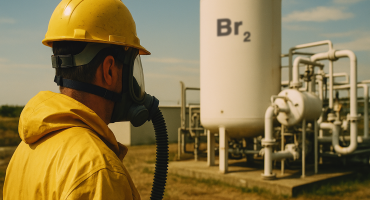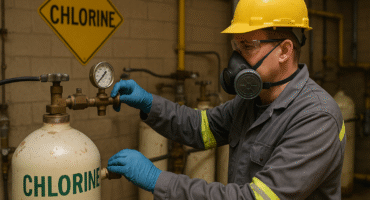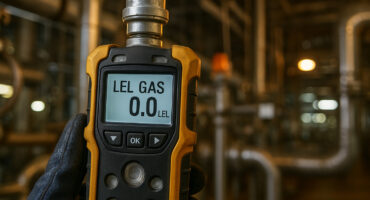MPS Stands For Molecular Property Spectrometer (MPS). It’s a specific type of chip, containing next-generation technology developed and patented by Nevadanano that allows gas detection of multiple chemical sensors on a single device. The chip can read data from a piezoelectric sensor. A Piezoelectric sensor allows the device to detect changes in pressure, humidity, temperature, strain, force etc through an electronic charge. This advanced technology reduces the need for more complex gas detection making MPS Sensors a low-cost solution to a highly complex problem. (1)
Essentially MPS Sensor is a Multi Gas Detector but much more robust compared to the standard multi-gas detectors available in todays market. A standard Multi Gas Detector can usually detect up to 4 gases, an MPS Sensor can detect up 14+ gases.
The MPS Sensor also requires little to no maintenance. An MPS Sensor using a technology called MEMS technology eliminates drift and deterioration meaning the device should not need calibration. (1)
Pellistor Sensor
Traditionally to detect flammable gases, a pellistor sensor might have been used which has two sensors confined within a housing unit, generally a set of coils. These sensors can heat to extreme levels and by using these temperature differences it can detect gases with accuracy (2) by using the principle of the fire triangle (3)
The coil, over time diminishes as heat causes deterioration so is not an ideal solution.
Nondispersive infrared sensors
A market alternative choice is Nondispersive infrared sensors (NDIR).
This type of sensor uses wavelengths to determine what gas compounds are present in the atmosphere by shining infrared (IR) light / sensors on a sample. The presence of gas is detected by a decrease in light that triggers an alarm if the desired wavelength isn’t reached.
There are a number of issues with this type of detector in that false alarms often sounds as dust and other a particles can also interrupt the wavelength of the IR light (3)
MPS Sensor
The MPS Sensor works in a similar manner to a pellistor sensor but there is no need for a coil meaning deterioration is limited. A change of temperature happens in milliseconds allowing the device to test more gases at very precise temperatures using a joule heater rather than a coil.
How does the MEMS sensor detect gas, and how does the environmental sensor help establish a baseline measurement?
1. Gas rapidly defuses through the sensor’s mesh screen and into the sensor chamber, entering the MEMS sensor module.
2. The joule heater rapidly heats the hot plate.
3. Real-time environmental conditions (temperature, pressure, and humidity) are measured by the integrated environmental sensor.
4. The energy required to heat the sample is precisely measured using a resistance thermometer.
5. The gas level, corrected for gas category and environmental conditions, is calculated and output to the gas detector.
Accuracy of Readings: After automatically applying real-time correction factors for the category of gas identified by the sensor and adjusting readings for temperature and humidity, the resulting readings are far more accurate than competing sensors.
Reliability: With built-in self-diagnostic ability and no risk of poisoning, the MPS sensor is failsafe. This means that if there is a failure with any component of the sensor, it will notify the user of the malfunction.
Environmental Factors: The sensor will maintain its accuracy through extreme temperatures, humidity, and pressure changes, so environmental factors are not a concern.
Below is a table of advantages and limitations of each type of sensor
| Sensor | Advantages | Limitations |
| MPSTM Sensor | -Immune to poisoning -Extended Lifetime (5+ years) -Detects full range of flammable gases -Accurately detects mixed gases -Classifies gases into one of six categories -Reduced false alarms due to built-in environmental compensation -Fail-safe, self-diagnostic capability | -Requires an oxygen atmosphere for accurate readings |
| Pellistor (Cat Bead) Sensor | -Detects full range of flammable gases -Predictable sensitivity and correction factors -Simple to operate -Long-lasting | -Susceptible to poisoning and inhibition -Requires an oxygen atmosphere for accurate readings -Sensor failures default to fail-to-unsafe -Significant variation in response to different gases -Readings are accurate for the target gas or when using correction factors. Other gases will be detected, but readings can be inaccurate. |
| Non-Dispersive Infrared (NDIR) Sensor | -Fail-to-safe failure modes -Immune to poisoning and inhibition -Low power consumption -Operates in oxygen-depleted and enriched environments | -Unable to detect hydrogen and acetylene -Readings are only accurate for the target gas. Other gases can be detected, but readings will be inaccurate |
Using MPS technology Blackline Safety have brought to the market the MPS Flammable Gas Sensor. A Gas Sensor that can detect 14 different hazardous combustible gases including hydrogen while eliminating a number of issues found with common sensors. It’s suitable for Oil & Gas, Petrochemical, Industrial Manufacturing, Water and Wastewater, Hazmat and Fire Response
Below are the gases that Blackline MPS Flamable Gas Sensor can detect.
Butane – C4H10
Ethane – C2H6
Hydrogen – H2
Isobutane – HC(CH3)3
Isobutylene – C4H8
Isopropanol – C3H8O
Methane – CH4
Methyl Ethyl Ketone – C4H8O
Octane – C8H18
Pentane – C5H12
Propane – C3H8
Propylene – C3H6
Toluene – C7H8
Xylene – C8H10
In addition to this the MPS Sensor can have an add on sensor to change the types of gas detected to suit your situation. These additional sensors.
Ammonia (NH3)
Ammonia: high-range (NH3)
Carbon dioxide (CO2)
Carbon monoxide (CO)
Carbon monoxide: high-range (CO)
Carbon monoxide: hydrogen-resistant (CO-H)
Carbon monoxide and hydrogen sulfide (COSH: CO/H2S)
Chlorine (Cl2)
Chlorine dioxide (ClO2)
Sulfur dioxide (SO2)
Combustible infrared (LEL-IR)
Combustible MPS (LEL-MPS)
Hydrogen cyanide (HCN)
Hydrogen sulfide (H2S)
Hydrogen sulfide: high-range (H2S)
Nitrogen dioxide (NO2)
Oxygen (O2)
Ozone (O3)
Photoionization detection (PID ppm)
From the Blog



If you have any questions about our products or services, please feel free to contact us.